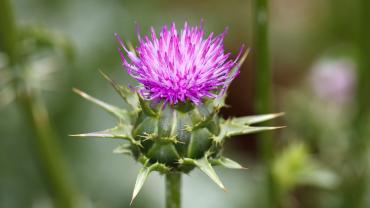
The shiny black seeds of the botanical milk thistle (Silybum marianum) have been used for centuries to support liver health. Milk thistle contains many bioactive constituents, which include silymarin, silibinin, isosilybin, and flavonols, including quercetin. Silymarin has been shown in studies to support the body’s response to oxidative stress and inflammation. Studies also indicate that silymarin may play a protective role in the presence of certain liver diseases and toxicities.
Oxidative stress has been linked to some diseases of the liver, including steatohepatitis, alcoholic and nonalcoholic fatty liver disease, and certain drug- and chemical-induced toxicities. In addition to its supportive role related to oxidative stress, silymarin has been shown in studies to promote hepatocyte regeneration, inhibit fibrogenesis, and potentially reduce the toxic effects of certain drugs. It has also been shown to attenuate the production of nitric oxide and inhibit inducible nitric oxide synthase.
In laboratory and clinical studies, silymarin was shown to preserve hepatic mitochondrial function and prevent severe oxidative stress in the presence of nonalcoholic steatohepatitis. Silymarin has also been shown to increase the activity of superoxide dismutase (SOD) and catalase. It has also been shown to inhibit lipid peroxidation and increase intracellular and liver glutathione levels.
In addition, silymarin has been studied for its supportive role in the presence of certain toxins. In the presence of arsenic, animal studies showed that silymarin regulated apoptosis. It also had a protective effect on mitochondrial membrane potential. One animal study assessed the efficacy of supplementation with silymarin for 15 days in rats exposed to sodium arsenite for 8 months. Study results showed significantly elevated glutathione levels and increased SOD and catalase activity.
In the presence of mercury, silymarin has been shown to protect against necrosis, reduce mercury-induced p38, and tumor necrosis factor-alpha activation, and it has also been shown to inhibit apoptosis. One animal study assessing the impact of silymarin on rats exposed to lead showed improvements in kidney histological changes and attenuation of DNA damage. It has also been shown to exhibit iron-chelating activity in the presence of iron overload.
Silibinin, another constituent of milk thistle, has been studied for its potential liver and detoxification support. In animal studies, silibinin has exhibited protective effects against toxicity due to cadmium exposure. One animal study showed a beneficial effect related to serum transaminase activity, lipid peroxidation, oxidative stress, and other markers related to hepatic injury. The mechanism of action is believed to be due to its free radical scavenging and metal chelation activities.
Milk thistle is originally from the Mediterranean region. Its use in support of liver health has been documented since ancient Greek and Roman times. Its constituents, such as silymarin and silibinin, have been shown to play a protective role in the presence of certain toxins and oxidative stress.
By Colleen Ambrose, ND, MAT